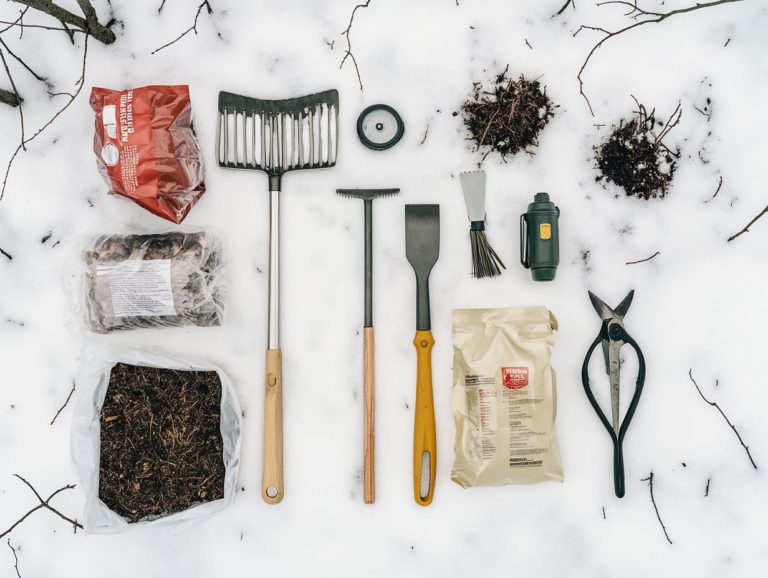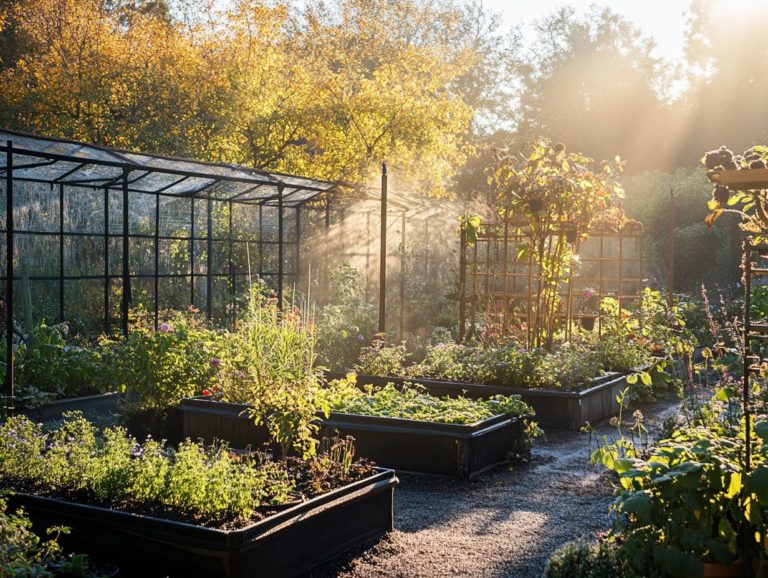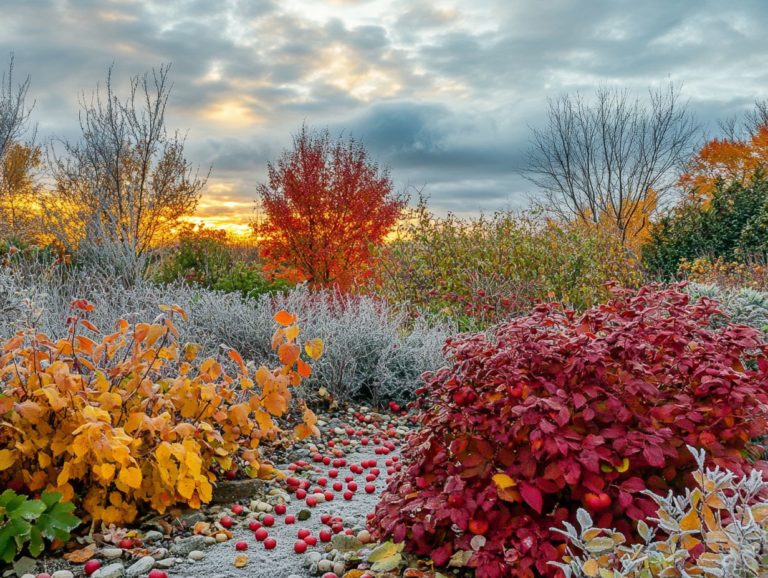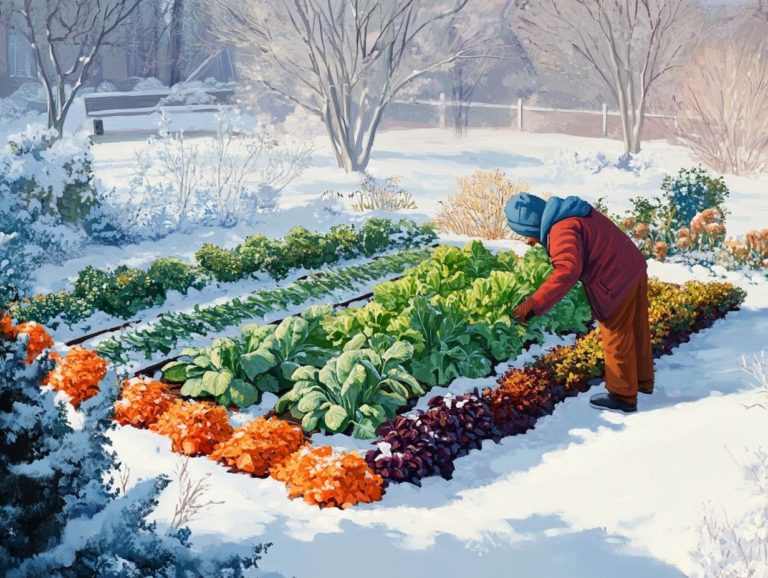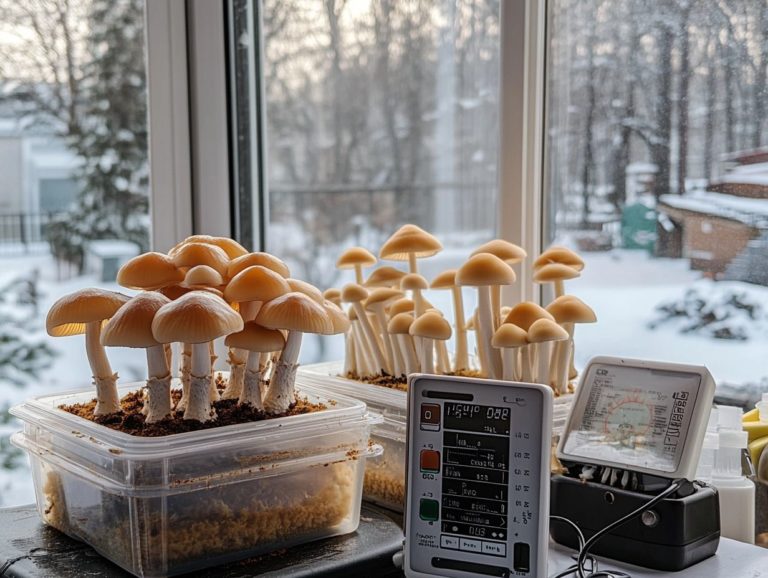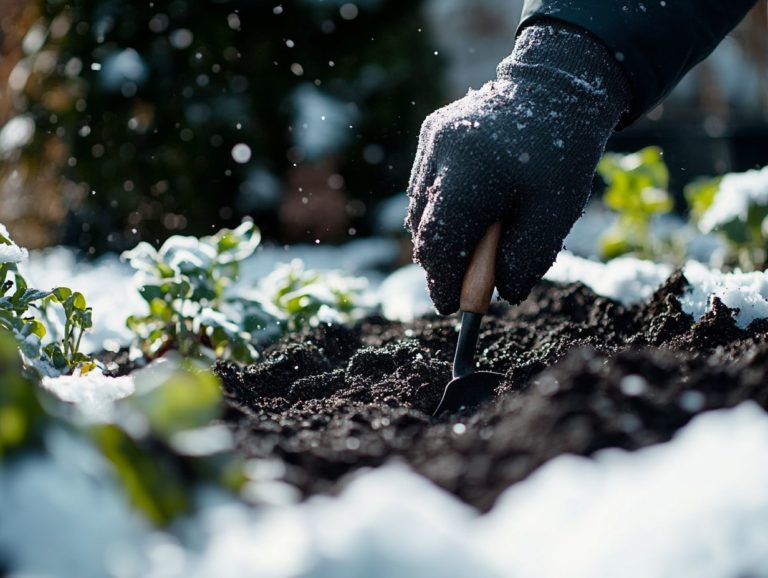Preparing Your Cold-Climate Garden for Rain
Understanding your garden’s drainage system is essential, especially in cold climates where excess rain can turn your soil into a soggy mess. This jeopardizes the health of your plants.
This guide empowers you to assess your soil type and slope effectively. By doing so, you can prepare your garden for impending rain, safeguarding your plants and structures from potential damage.
Explore efficient mulching techniques, uncover the advantages of rainwater collection, and discover sustainable drainage solutions. These strategies will help ensure your garden flourishes, no matter the weather conditions.
Contents
- Key Takeaways:
- Understanding Your Garden’s Drainage System
- Preparing Your Garden for Rain
- Using Mulch to Prevent Waterlogging
- Implementing a Rainwater Collection System
- Planning for Long-Term Drainage Solutions
- Frequently Asked Questions
- How can I prepare my cold climate garden for rain?
- Why is cleaning and clearing debris important for maintaining a thriving garden?
- How can I improve drainage in my cold-climate garden, considering Wyoming weather?
- What type of mulch is best for preparing a cold-climate garden for rain?
- How do I choose appropriate plants for a cold-climate rain garden?
- Can I use rain barrels to collect rainwater for my garden?
Key Takeaways:

- Assess your garden’s drainage system by understanding soil type and slope before preparing for rain.
- Clear debris and improve drainage to protect your plants and structures.
- Use mulch to prevent waterlogging by selecting the right type and applying it correctly. Consider rainwater collection systems and plan for long-term drainage solutions for sustainable gardening.
Understanding Your Garden’s Drainage System
Understanding your garden’s drainage system is crucial, particularly in areas like Wyoming, where the cold climate can greatly influence your growing season. For those looking to enhance their gardens, selecting cold-climate plants for urban gardens can make a significant difference.
An effective drainage system does more than retain moisture; it actively prevents root rot a condition where plant roots decay due to excess water and plant diseases that can compromise your efforts.
Evaluate soil type and slope, and consider incorporating features like raised beds or season extenders. For more detailed guidance, look into updating your cold-climate gardening resources. These steps allow you to cultivate a flourishing environment for your plants year-round, even with the looming threat of the first frost and second frost.
Assessing Soil Type and Slope
Assessing your soil type and slope is key for creating an efficient drainage system in your garden. This ensures optimal conditions for your vegetable garden and enhances plant hardiness.
Understanding various soil types sandy, clay, and loamy significantly influences how water moves through the ground and how quickly it drains away. For example, sandy soils offer excellent drainage, reducing the risk of root rot. Conversely, clay soils often hold moisture, which can lead to potentially waterlogged conditions.
The slope of your garden is equally important. It directs water runoff. Steeper slopes can increase erosion, washing away vital nutrients and destabilizing plant roots. By considering these factors, you can make informed decisions about which plants will thrive in specific areas, fostering a healthier and more productive garden environment.
Preparing Your Garden for Rain
Preparing your garden for rain is crucial for promoting healthy growth and preventing waterlogging. For those in colder regions, preparing your soil for spring can further protect your plants during the growing season.
By taking the right steps, you can create an environment where your garden can thrive, even in wet conditions. For detailed guidance, check out our article on preparing your garden for winter.
Clearing Debris and Improving Drainage
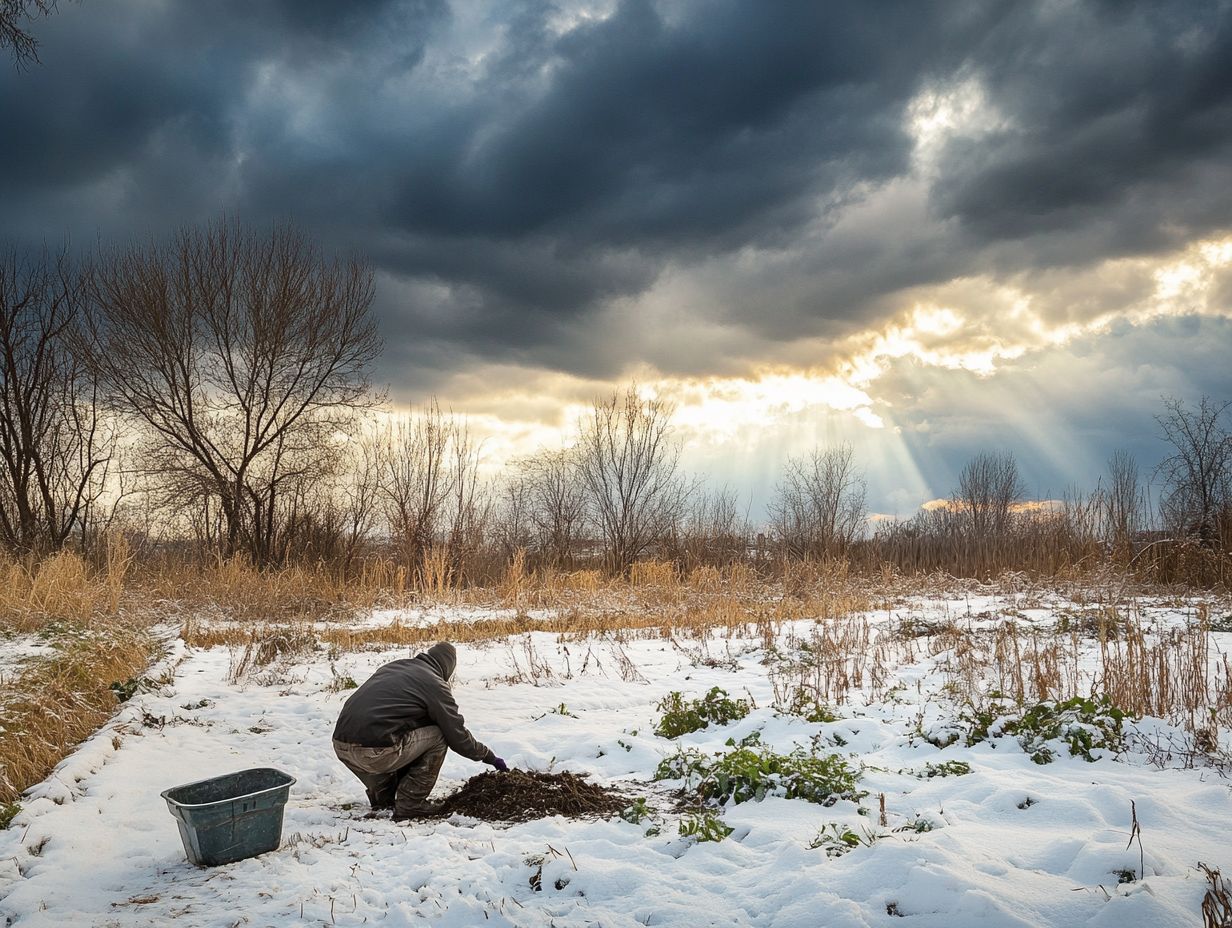
Clearing debris from your garden is essential for enhancing drainage and fostering a healthy environment for your plants.
Regularly remove fallen leaves, twigs, and other organic materials to elevate the garden’s aesthetics and ensure that water flows freely. This prevents pooling that could suffocate roots. A tidy garden minimizes the risk of pests and diseases, which thrive in disordered spaces.
Regularly check drainage channels for clogs. Clogs can disrupt proper water flow and potentially lead to soil erosion. Inspect these pathways routinely to keep them clear, allowing for optimal water drainage and significantly contributing to your soil’s overall health.
How prepared is your garden for the next downpour?
Protecting Plants and Structures
Protecting your plants and garden structures is essential, particularly during heavy rain or unexpected weather changes. Additionally, focusing on soil preparation for container gardening in cold climates guarantees a successful growing season.
Hoop houses and cold frames enhance plant resilience. They create a controlled environment that shields plants from adverse conditions. These structures not only trap heat to maintain optimal temperatures, but they also act as a protective barrier against fierce winds and relentless downpours.
Reinforcing your garden beds and trellises secures them against harsh weather. Anchoring loose structures and ensuring proper drainage are critical strategies to prevent damage. By implementing these protective measures, you can cultivate a thriving landscape, ensuring your plants remain healthy and vibrant throughout the season.
Using Mulch to Prevent Waterlogging
Using mulch is an effective way to prevent waterlogging in your garden. It helps maintain the right amount of moisture while safeguarding your vegetable garden from erosion and curbing the growth of pesky weeds.
Types of Mulch and How to Apply
You have a variety of mulch options for enhancing your vegetable garden, each offering unique benefits for soil health and moisture retention.
Consider wood chips; they serve as a formidable barrier against weeds and decompose gradually, enriching your soil over time. Straw, on the other hand, is lightweight and excels at maintaining moisture levels, making it particularly suited for warmer climates. If you re in an area that experiences heavy rainfall, rocks can be your best ally, providing excellent drainage and reducing the risk of waterlogging.
To truly maximize the benefits of these mulches, aim to apply them at a depth of about three to four inches. This gives enough coverage while letting water soak in well. Layering different types can create a more resilient ecosystem that fosters robust plant growth and overall health.
Implementing a Rainwater Collection System
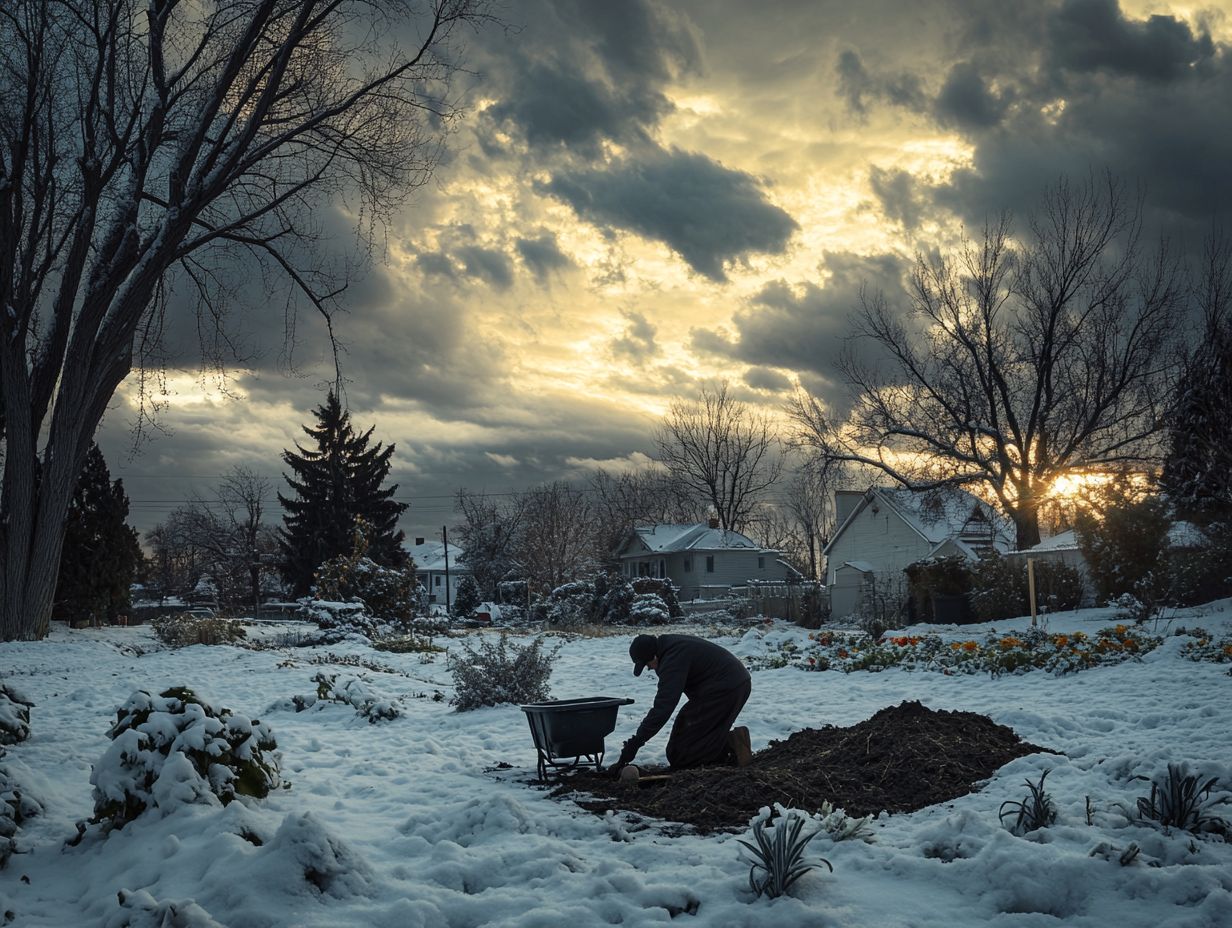
Implementing a rainwater collection system can elevate your gardening to new heights, especially in colder climates such as Wyoming, where the weather can be unpredictable. Additionally, understanding the role of snow in cold-climate gardening can further enhance your gardening strategy.
This approach not only provides a sustainable water source during the growing season, but it also aligns seamlessly with your commitment to eco-friendly practices.
Benefits and Setup Process
The benefits of rainwater collection are impressive, offering everything from reduced water bills to healthier plants thriving on the natural hydration provided by collected rainwater.
This eco-friendly practice conserves your precious freshwater supply and minimizes stormwater runoff and erosion. By harnessing rainwater, you grant your plants the natural nutrients they need, promoting robust growth while embracing a more sustainable gardening approach. If you’re considering this method, setting up a rainwater collection system at home is both simple and beneficial.
- Start by selecting an ideal spot for your rain barrel ideally close to downspouts to maximize your collection efficiency.
- Next, gather the necessary tools, including a barrel, gutter connectors, and a screen to keep out debris.
- After installation, remember to maintain the system regularly to ensure it operates at peak efficiency, allowing you to fully enjoy these remarkable rewards.
Planning for Long-Term Drainage Solutions
Planning for long-term drainage solutions in your garden is crucial for fostering healthy plant growth, particularly in colder climates where rainfall can be unpredictable and potentially harmful. To help with this, consider preparing your garden for the first frost.
By taking the time to create a well-thought-out drainage system, you not only protect your plants but also enhance the overall resilience of your garden.
Try these methods today for a flourishing garden!
Strategies for Sustainable Drainage
Implementing strategies for sustainable drainage is essential for maintaining plant health and embracing a more eco-friendly approach to gardening.
These strategies help manage water effectively and enhance natural water flow, creating a more balanced ecosystem. By using permeable materials materials that allow water to pass through for paths and driveways or incorporating rain gardens, you can significantly improve soil saturation and minimize runoff.
Incorporating elements like swales, which are shallow ditches that help collect rainwater, allows for better absorption of rainwater. This ensures that your plants receive the moisture they need without becoming waterlogged.
Ultimately, adopting these methods will help you cultivate a thriving gardening environment while contributing to environmental sustainability.
Frequently Asked Questions
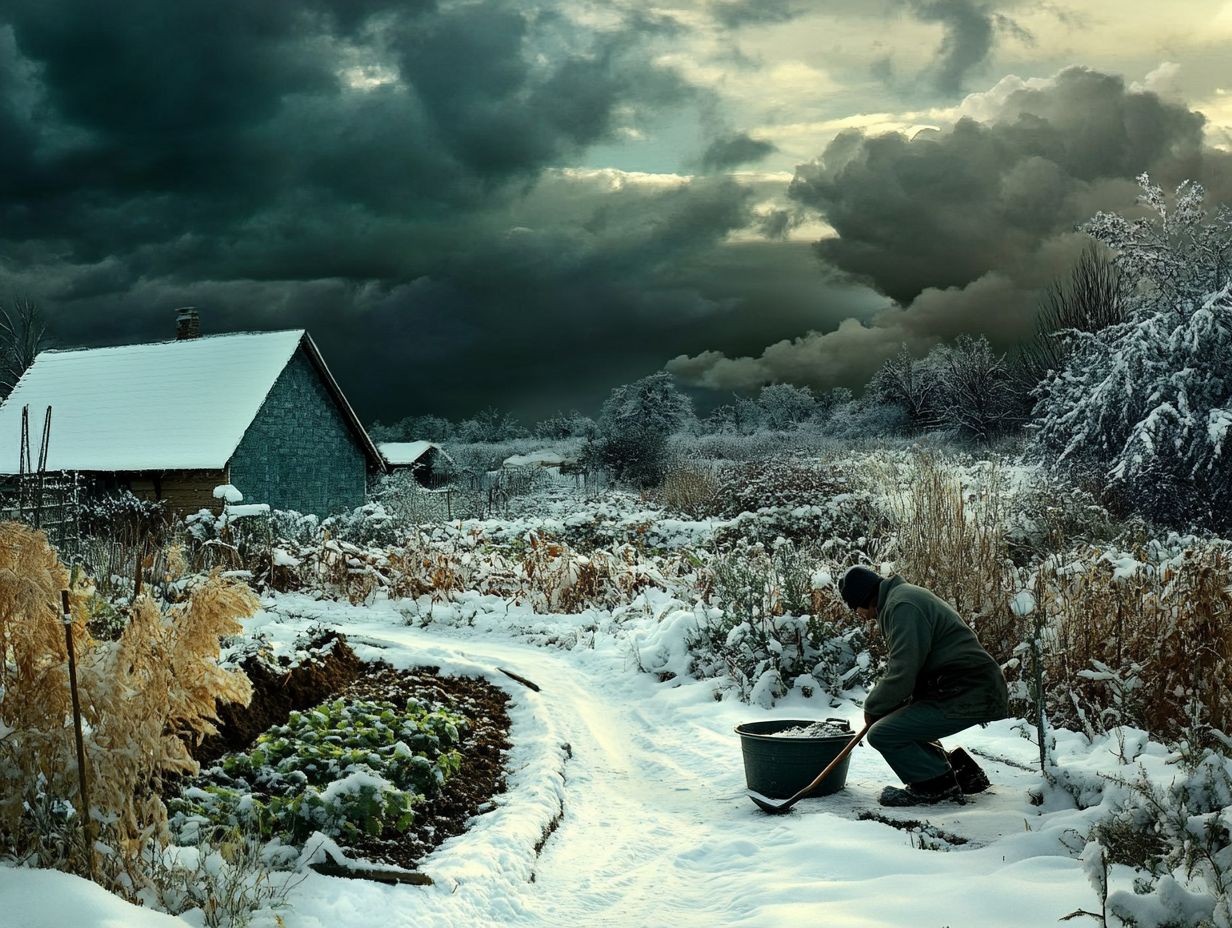
How can I prepare my cold climate garden for rain?
To prepare your garden for rain in a cold climate, follow these steps: clean and clear debris, improve drainage, mulch, and choose appropriate plants.
Why is cleaning and clearing debris important for maintaining a thriving garden?
Cleaning and clearing debris helps prevent clogs and buildup in drains and gutters, which can cause water to pool and potentially damage your plants. This practice also reduces the risk of diseases and pests in your garden, especially if you are mindful of your garden zone.
How can I improve drainage in my cold-climate garden, considering Wyoming weather?
Want to improve drainage? Create channels or slopes to steer water away from your plants. You can also use raised beds, add gravel or stones to your soil, or install drainage pipes or French drains. Using vermiculite can help improve soil structure.
What type of mulch is best for preparing a cold-climate garden for rain?
In a cold climate, heavy mulch such as straw, hay, or wood chips is best. These types of mulch resist being washed away by heavy rain and help retain moisture in the soil, especially when preparing an herb garden.
How do I choose appropriate plants for a cold-climate rain garden?
When selecting plants for a cold-climate rain garden, look for species native to the area, such as Austrian Pines and Ponderosa Pines. These plants can withstand heavy rain and colder temperatures, while avoiding those sensitive to waterlogged soils. Additionally, preparing your garden for winter is essential for ensuring their health. Consider using the USDA Plant Hardiness Map for guidance.
Can I use rain barrels to collect rainwater for my garden?
Yes, rain barrels are a great way to collect and store rainwater for your garden, particularly for crops like tomatoes, corn, and kale. Don t wait for the rain to start! Collect water today to keep your plants thriving! Just remember to properly maintain and clean your rain barrels to prevent contamination of the collected water. Also, consider using cloches or a hoop house to protect young seedlings during unpredictable weather.

